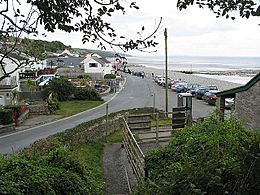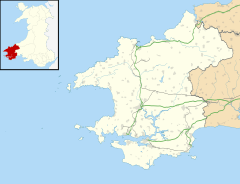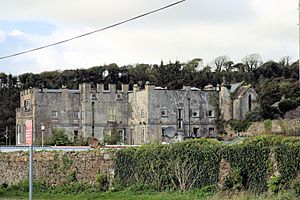Amroth facts for kids
Quick facts for kids Amroth |
|
|---|---|
 Amroth village and beach |
|
| Population | 1,232 (2011) |
| OS grid reference | SN1607 |
| Community |
|
| Principal area | |
| Country | Wales |
| Sovereign state | United Kingdom |
| Post town | NARBERTH |
| Postcode district | SA67 |
| Dialling code | 01834 |
| Police | Dyfed-Powys |
| Fire | Mid and West Wales |
| Ambulance | Welsh |
| EU Parliament | Wales |
Amroth is a lovely village, parish, and community in Pembrokeshire, Wales. It's about 7 miles northeast of Tenby. Amroth is famous for its long, sandy beach right on Carmarthen Bay. This beach often wins a special award called the Blue Flag. It's also the starting point for the famous Pembrokeshire Coast Path. Amroth is part of the beautiful Pembrokeshire Coast National Park.
The name Amroth comes from the Welsh language. It probably means "on the brook called Rhath."
Contents
Discovering Amroth's Past
The beach at Amroth stretches along the entire village. If you visit at a very low tide, you might see something amazing. You can spot parts of a petrified forest. This forest was covered when sea levels rose about 7,000 years ago.
Scientists have found many interesting things here. They've discovered fossilised antlers, old nuts, and animal bones. They've also found Neolithic flints, which are tools from the Stone Age.
Amroth's Mining History
The area around Amroth was once very important for anthracite coal mining. This continued until the late 1800s. Today, you can still see small remains of the old mines and their special tracks called tramways.
St Elidyr's Church
Inland from the village, you'll find the Anglican parish church of St Elidyr. This church is a very old and important building. It is listed as a grade II* building, meaning it has special historical interest.
Exploring Amroth Castle
Amroth Castle stands on the north side of the coast road, just east of Amroth village. A tall wall surrounds it, with an archway at the entrance. The castle you see today is a country house built in the 1800s. It looks like a mock castle, which means it was built to look like an old castle. It might have replaced a smaller stone castle from the 1100s. The gatehouse has been repaired quite a bit. The old parts of the house are listed as a grade I building.
Over the years, Amroth Castle has had many different owners. For a time in the 1850s, it was used for special care. In the 1880s, it became a private home again. Later, a shipping leader named Owen Colby Philipps owned it. He was a very important person who bought the famous White Star Line. He was given the title Baron Kylsant in 1923. His daughter, Nesta, later owned the castle.
Walking and Exploring Trails
Amroth is a great place for walking! The famous Pembrokeshire Coast Path starts here. This national trail goes west along the coast. Since 2012, it has also been part of the Wales Coast Path. The Wales Coast Path continues east from Amroth, going over Telpyn Point towards Pendine.
Amroth is also the southern end of the Knights' Way. This path goes north all the way to St Davids Cathedral. A part of the Cistercian Way also passes through Amroth.
How Amroth is Governed
Amroth is an electoral ward and a community in Pembrokeshire. This area includes Amroth itself, along with places like Crunwere, Summerhill, Stepaside, Pleasant Valley, Wisemans Bridge, Llanteg, and Llanteglos.
The people of the ward choose a councillor to represent them. This councillor works for the Pembrokeshire County Council. They also elect up to twelve community councillors to the Amroth Community Council. These councillors help make decisions for the local area.
Village Amenities
Amroth beach is a big attraction. In 2020, it won a Blue Flag award, which means it's a very clean and safe beach. During part of the summer, lifeguards are on duty at the eastern end of the beach to help keep swimmers safe.
You can find public toilets at both ends of the village. The main car park in Amroth is managed by the Pembrokeshire Coast National Park Authority.



